Hippeastrum spp.
Amaryllis, Hippeastrum x hybridum, is not one specific type, but rather any one of hundreds of hybrids of Hippeastrum species in the Amaryllidaceae family.
Suited to outdoor growing as a perennial in USDA Hardiness Zones 9 to 11, this showy flower is often forced to bloom indoors in other zones.
An exceptional addition to winter holiday decor, the large flowers of amaryllis are trumpet-shaped and perch atop leafless, hollow stems that rise directly from a substantial bulb.

We link to vendors to help you find relevant products. If you buy from one of our links, we may earn a commission.
You’ll find a range of available colors to choose from, including shades of orange, pink, purple, red, white, and yellow. Often the petals are variegated, and some types are fragrant.
In this article, we discuss how to cultivate amaryllis indoors.
Here’s what’s in store:
What You’ll Learn
Don’t be intimidated by this dazzling flower. It’s so easy to grow, you won’t believe it!
Cultivation and History
Amaryllis is generally purchased in a dormant state. It may be cultivated with a combination of indoor and outdoor placements, and artificially-induced dormancy, for year-to-year enjoyment in cold regions, or it may be discarded after blooming indoors.

Hippeastrum bulbs have a circumference of 10 to 14 inches. The larger the bulb, the more stems and flowers it will typically produce.
The stems, called scapes, are between one and two feet tall. There may be one to three scapes per bulb.
Each erect stem bursts into robust blooms with a diameter between four and 10 inches. They face outward, like colorful sentries on watch. There may be up to five flowers per stem.
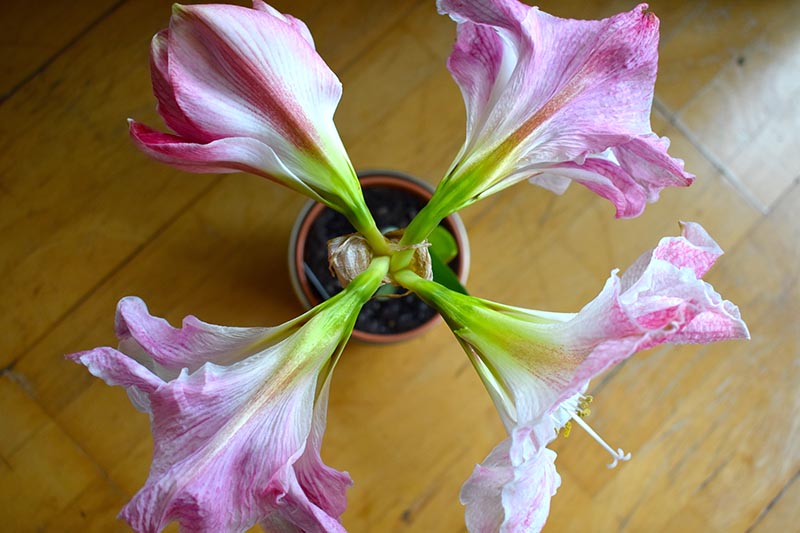
There’s a variety of hybrids to choose from, including multi-petal Nymphs, narrow-petal Cybisters, and butterfly-like Papilios.
Strappy leaves sprout directly from each bulb, and reach lengths of up to three feet.
By definition, there is only one true amaryllis species, Amaryllis belladonna. Also known as the March or naked-lady lily, it’s an outdoor plant that blooms in the late summer in Zones 7 to 10, and is native to South Africa. You can read more about growing it in our guide. (coming soon!)
So, why do we call Hippeastrum hybrids amaryllis?
In the 1700s, Swedish botanist Charles Linneaus created the Amaryllis genus to classify A. belladonna, its only member at the time.
In the 1800s, British botanist William Herbert named lily-like flowers that resembled “knight’s stars” Hippeastrum, Latin for the description.
Over the years, both the single South African Amaryllis and multiple South American Hippeastrum species were all classified as Amaryllis.
It wasn’t until modern times, in 1987 to be exact, that the 14th International Botanical Congress determined that there are indeed two separate genera, Amaryllis and Hippeastrum. And although the distinction has been made, we still call Hippeastrum flowers amaryllis.
Propagation
There are four ways to start this misnamed lily-like plant: from seed, or via offset division, bulb re-sectioning, or micropropagation of explant cultures.
Let’s look at what each means for the home gardener.
Seed
Not all Hippeastrum plants produce viable seeds.
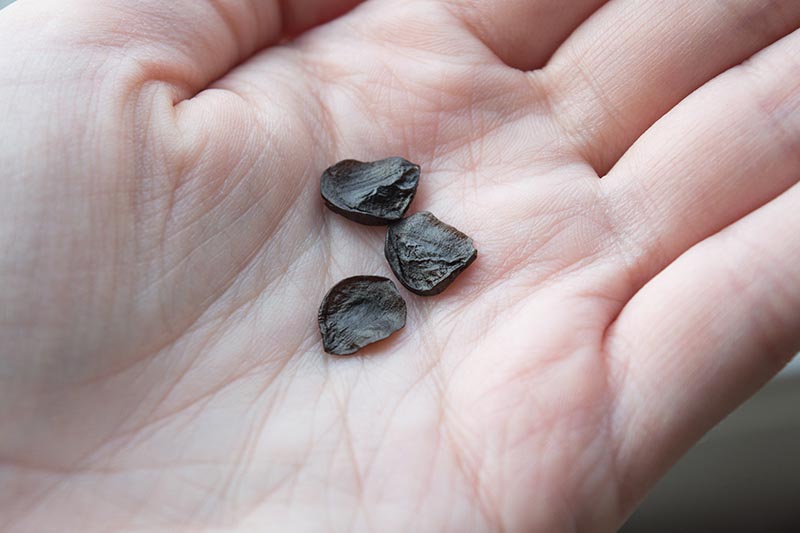
With fertile seed, however, starting a new plant is cost-effective, if time consuming. From the time of sowing, the appearance of the first blossom may take two to five years.
The traits of plants propagated by fertile seed are likely to vary from those of the parent plant.
For more information on growing amaryllis from seed, see our guide.
Bulb
The easiest way to start a plant is with a dormant bulb.
Both loose and pre-potted bulbs are available for indoor forcing, or outdoor sowing in warm areas.
Once dormancy is broken, it takes between six and eight weeks for flowering to occur.
Offset Division
Offsets are bulblets, or “daughters,” that grow alongside a large “mother” bulb. They are broken away from the mother to start new plants and reduce crowding.
The larger the offset, the better, because they take from two to five years to bloom, depending upon their size.
The best time to divide is in late fall, but for those in warm regions, it is also possible to divide in late winter.
Offset division produces plants with the same characteristics as a parent plant.
Bulb Re-Sectioning
A bulb can be dug up and cut into sections to create new plants. This is a common commercial practice, also known as twin scaling.
The best time to do this is after a bulb has bloomed and grown foliage, but before the leaves fade and dormancy begins.
It’s done by removing the brown “tunic” and dividing the bulb like a pie, with multiple sections that each contain a bit of outer scale and basal plate, the bottom where the roots are attached.
The sections are cut and then treated with a fungicide before being planted in a moist, sterile potting medium. Sections may begin to regrow in one to three months, but it may take two or more years before they flower.
Read more about separating amaryllis offsets and bulb re-sectioning in our guide.
Micropropagation of Explant Cultures
The domain of scientists, this method of micropropagation involves taking samples of plant tissue and growing them in a laboratory. This method enables the manipulation of traits at the genetic level.
How to Grow
Purchase a dormant bulb in the fall. Don’t be surprised if it has already sprouted in transit.
For pre-potted bulbs, follow the enclosed instructions.
Don’t forget to remove the layer of Spanish moss before watering if there is one, so it doesn’t soak up the water intended to saturate the potting medium. Replace it after watering, to promote moisture retention.
When shopping, you are likely to come across wax-dipped bulbs. They are unique in that they require no soil or water to bloom.
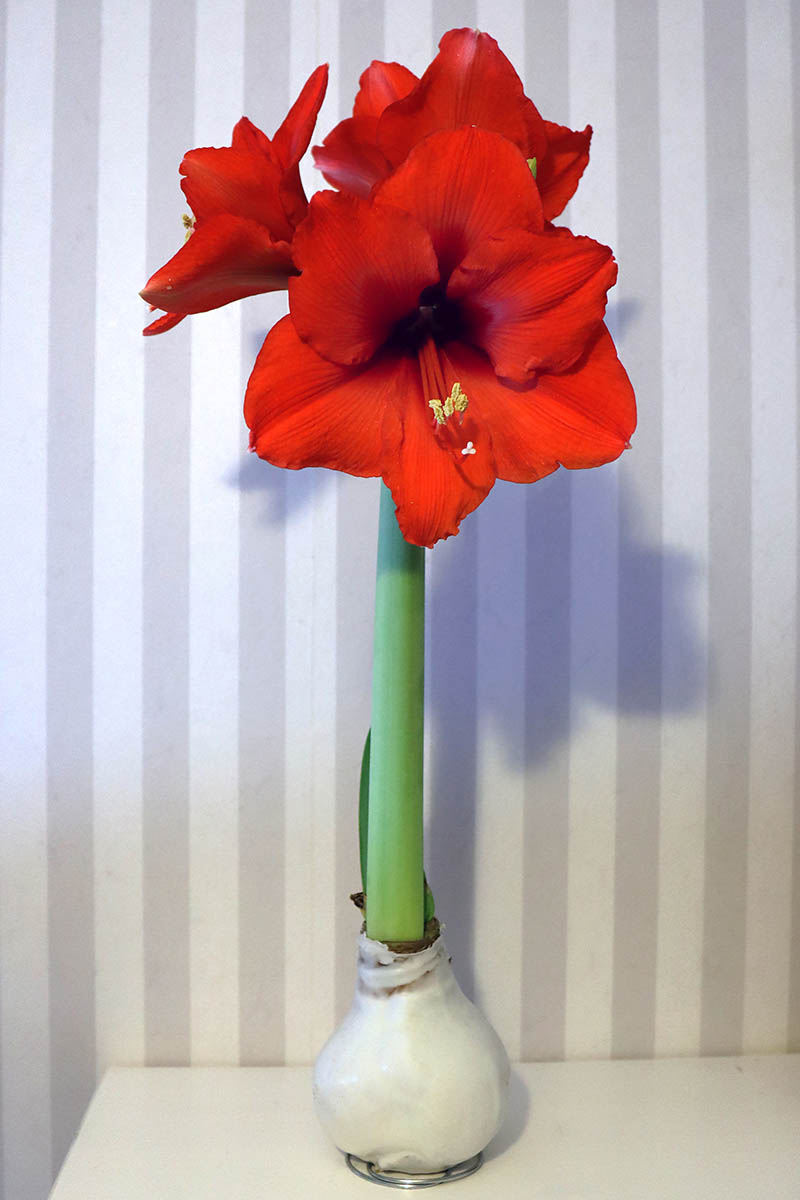
Each is a “one-hit wonder” that probably won’t bloom again, however, purveyors suggest there’s no harm in removing the wax and giving it a try.
For something unique that will be used and tossed, such as party centerpieces, they are a novelty you might like to try.
And because they require no water, you can suspend waxed bulbs upside-down to astonish your guests with a gravity-defying display!
Another novelty is the moss-wrapped bulb. Attractively ensconced in sheet moss that is secured by decorative wire, it requires a mere misting to sprout and bloom.
Potting a Loose Bulb for Forcing Indoors
To force blooming indoors in winter, choose a container with adequate drainage holes and enough weight that your plant will not tip over.
If you have a light pot, you may add stones to the bottom for ballast.
The pot diameter should allow for two inches of space around the bulb on all sides, for a snug fit that allows room for watering. And unlike many other plants, being rootbound is preferred.
If you wish to plant more than one bulb in a container, keep in mind that each plant measures between six and 12 inches wide at maturity, depending upon the variety.
Add a good quality potting medium, preferably a sterile mix, to the container, and settle the bulb in so that one-third to one-half of the narrower “neck” part is above the surface. This elevation inhibits rotting.

Press the soil down firmly, and be sure its height is one inch below the pot rim, to allow for watering without overflowing.
After planting, water the potting medium thoroughly.
Set the pot in bright sunlight, preferably in a location that is between 75 and 80°F. The kitchen is generally a good place for sprouting. You may use a heat mat as needed, to maintain an even temperature.
Rotate the pot a quarter turn daily to encourage upright stem growth, as it will tend to lean towards the light.
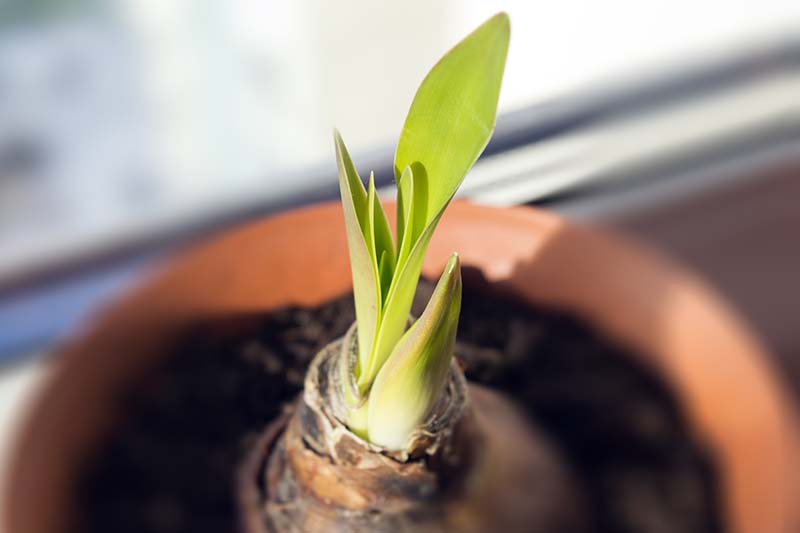
Keep the potting medium thoroughly moist until you see the first sprout.
Thereafter, water when the top few inches feel dry, but before the pot dries out completely.
If your bulb was already sprouted when you got it, proceed with watering when the top few inches of the potting medium feel dry.
When the first bud appears, move the plant into indirect, but bright sunlight.
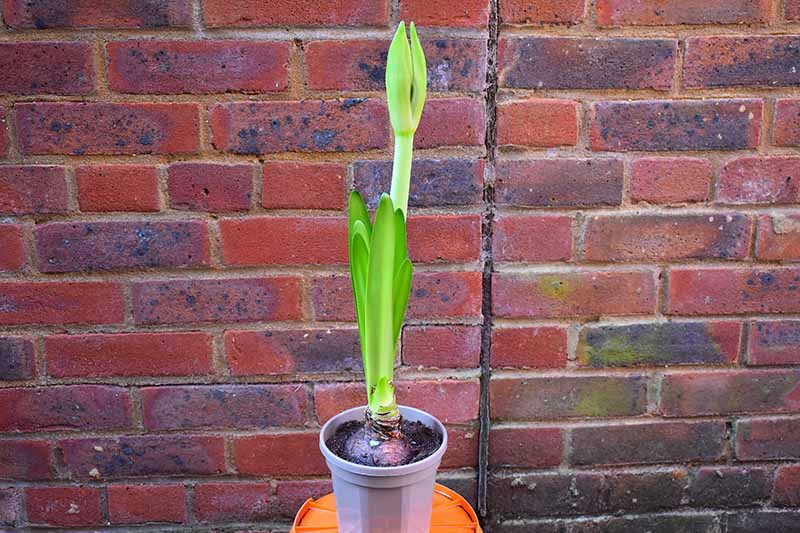
After blooming for four to six weeks, if you plan to keep your amaryllis to rebloom the next year, cut off spent flower stems to make way for a proliferation of foliage.
Continue to water sparingly, now allowing the pot to dry out before watering again.
There’s another way to pot a bulb for forcing indoors, and that’s by placing it on a single layer of pebbles in a glass container with water up to its neck, instead of potting medium.
It’s a novel approach you may want to try.
Find more tips on forcing amaryllis bulbs here.
Transitioning to the Outdoors in Spring
Though many people choose to toss their holiday amaryllis, you can keep it growing for beautiful blooms in years to come!
In the spring, after the last frost date for your region, you may move the pot outside, or plant the bulb directly into the garden soil in all temperate zones.
Some folks like to sink the entire pot into the ground, leaving the rim above the soil surface, for easy retrieval later. And some gardeners even go so far as to wrap the pot in a gauzy material first to deter crawling pests.
Other people prefer to keep their plants indoors.
The ideal placement is in a location that gets full sun to part shade.
At this time, you may add an evenly balanced fertilizer, such as a 6-6-6 or 10-10-10 (NPK) product, to promote foliar growth, which in turn nourishes next year’s flowers.
Learn more about growing amaryllis outside in our full guide.
Growing Tips
- Plant neck deep, or with one-third to one-half visible above the soil line.
- Provide bright sunshine and warmth to encourage sprouting.
- Water only the potting medium, not the bulb or foliage, to prevent rotting.
- Do not overwater.
- Plant snugly, with a maximum of two inches of space between the bulb and the container.
Pruning and Maintenance
This is a low-maintenance plant.
While the scapes are usually self-supporting, those that have stretched sideways to reach for sunlight may require staking.
You can buy decorative amaryllis support stakes, such as these from the Easy to Grow Store, available via Amazon.

Repot as needed every few years to keep bulbs snug. Divide as desired by removing large offsets to plant elsewhere.
For outdoor plants and those you want to rebloom, fertilize each spring with a well-balanced fertilizer. In warm regions, you may also fertilize during the growing season, per package instructions.
Continue to water sparingly after flowering, and remove spent scapes to inhibit pests and disease, and encourage foliar growth. We have more tips on post-bloom care here.
In cold regions, you can dig up bulbs to bring indoors for reblooming.
Divide offsets as desired in late fall, or in late winter in warm locales.
Cultivars to Select
There are hundreds of cultivated hybrids available each fall for forcing indoors, or planting outdoors in Zones 9 to 11.
Here are some of my favorite selections to whet your appetite:
Flamenco Queen
You’ll shout, “Ole!” when you see the luscious red and cream blooms of ‘Flamenco Queen.’ Bold and zesty, she’ll dance her way into your heart.
Large bulbs produce two stems and four to five blossoms.
Find ‘Flamenco Queen’ bulbs available from Burpee.
Browse all of Burpee’s amaryllis selections here.
Grand Diva
Bright and jolly, ‘Grand Diva’ is the epitome of Christmas amaryllis perfection. Saturated deep red petals are the perfect contrast to the evergreen of the season.
Find ‘Grand Diva’ bulbs available from Burpee.
You can also find red-blooming waxed amaryllis bulbs available from Eden Brothers.
Wax colors are available in a variety of styles, and flowers are of an unspecified red variety. A wire base allows the waxed bulb to be set on any flat surface – no need for a pot!
Moss-wrapped bulbs with white flowers are available from Gardener’s Supply.
Each bulb is encased in a layer of green sheet moss and wrapped in copper wire, for a refreshingly earthy display.
You will also find a fine selection of bulbs from the folks at Burpee.
And for even more exciting varieties, with intriguing names like ‘Cherry Nymph,’ ‘Half and Half,’ and ‘Purple Rain,’ see our article, 17 Awesome Amaryllis Varieties to Grow Indoors or Out.
Managing Pests and Disease
The best ways to avoid any issues with Hippeastrum hybrids is by starting with high-quality healthy plants. After you’ve gotten them home, do not overwater them.
Indoor growing reduces exposure to insects and infection, provided your other houseplants are healthy, and the potting medium that you use (or that your plants came in) is sterile.
For small infestations of sap-sucking pests like mealybugs and spider mites, you may be able to rinse them off with a steady stream of water. For a large-scale infestation, you may need to apply an insecticidal soap or neem oil.
Fungus gnat larvae feed below the soil and cause foliar deformity. Neem oil is the solution here, as well, and can head off diseases spread by young nymphs, such as wilt and blight.
Common diseases include red blotch and soft bulb rot.
Red blotch appears as rusty patches on foliage that often progress to the point of plant collapse. With proper sunlight and watering, it can be avoided. Discard affected plants.
Southern blight is a fungal infection that can occur in oversaturated soil. Read more about it in our guide.
Best Uses
For those of us in cool regions, forcing flowering indoors is a wonderful way to experience the beauty of amaryllis.
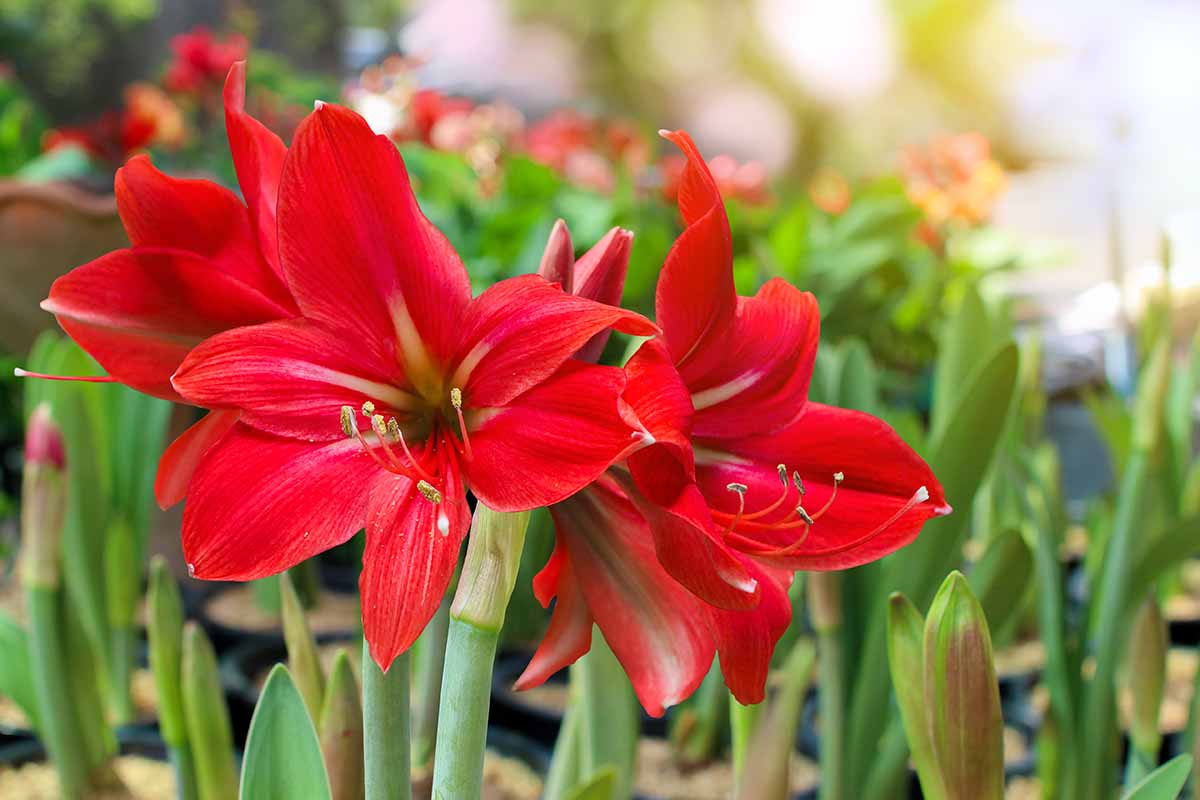
Whether you choose waxed, moss-covered, pre-potted, or loose bulbs to plant yourself in water or sterile potting medium, they’re a luxurious addition to winter decor. Stylish and awe-inspiring, holiday visitors are certain to want one of their own.
And why not?
If you’re looking for the perfect gift for family and friends of all ages and genders, who celebrate a variety of holidays, and who may be gardeners or not, it’s the perfect choice.
Quick Reference Growing Guide
| Plant Type: | Perennial flowering bulb | Flower / Foliage Color: | Pink, red, white, orange, yellow, purple, variegated/green |
| Native to: | South America | Maintenance: | Low |
| Hardiness (USDA Zone): | 9-11 | Tolerance: | Drought, after established |
| Bloom Time / Season: | Winter indoors/spring outdoors | Soil Type: | Organically rich |
| Exposure: | Full sun to part shade | Soil pH: | 6.0-6.5 |
| Time to Maturity: | 6-10 weeks (bulb); approx. 5 years (seed) | Soil Drainage: | Well-draining |
| Spacing: | 12-15 inches | Best Uses: | Containers, houseplant, outdoors in warm climates |
| Planting Depth: | One-third above soil (bulb) | Order: | Asparagales |
| Height: | 12-36 inches | Family: | Amaryllidaceae |
| Spread: | 6-12 inches | Genus: | Hippeastrum |
| Water Needs: | Moderate | Species: | x hybrid |
| Common Pests: | Aphids, bulb mites, grasshoppers, nematodes, mealybugs, slugs, snails, spider mites, thrips, rodents | Common Diseases: | Red blotch, Southern blight |
Herald of the Season
I encourage you to cultivate this flowering bulb.
Until my family received one as a gift, I’d actually never seen an amaryllis up close before.
One look at the enormous brown bulb nestled in rich, dark potting medium, covered in Spanish moss, and I was intrigued.
And when creamy white flowers with pink blushing edges the size of my hand shot out of the top of the single stem as fast as Jack’s beanstalk, I knew I had a new favorite.

My tropical treasure grew lush, leathery foliage when I planted it out in the yard after it bloomed. Unfortunately, I didn’t know at the time that my zone was unsuited to wintering over, and I lost it.
Gardening is a gamble, even with ample knowledge and ideal circumstances. But armed with the tips described here, I’m confident that yours will thrive.
Choose bold reds and brilliant whites to complement winter seasonal decor.
In warm climes, choose from an array of bright oranges to subtle shades of peach for a warm or cool spring garden scheme planted outdoors.
Winter or spring, the statuesque scapes and bold trumpets are sure to proclaim its arrival with a dramatic flourish!
Are you growing amaryllis indoors? Let us know in the comments section below, and feel free to share a picture!
For more winter flora for the holidays, you’ll enjoy reading these guides next:
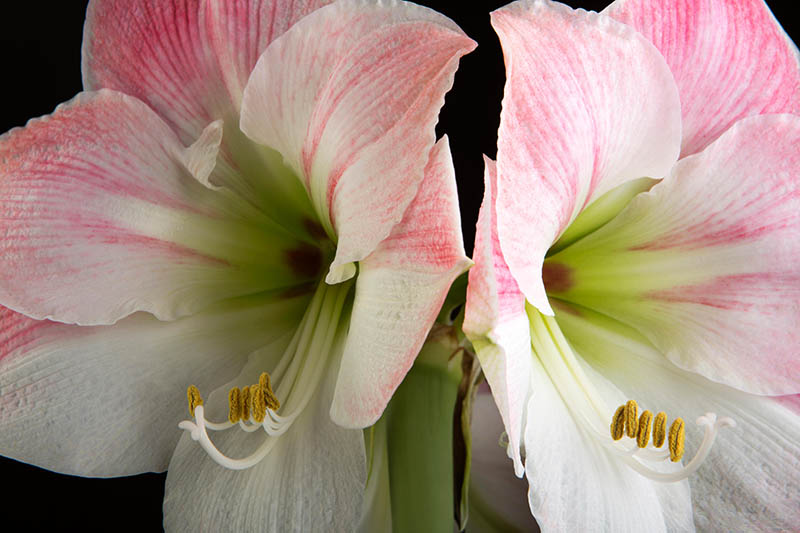
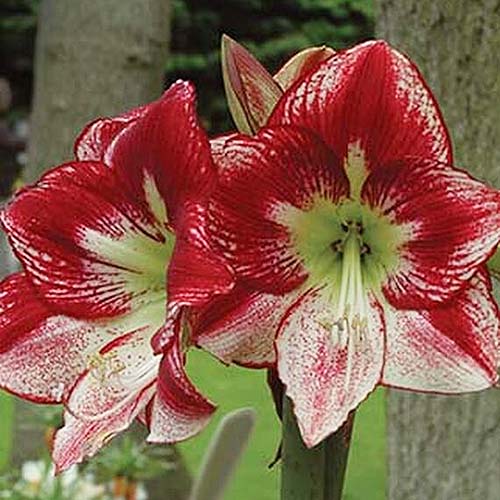
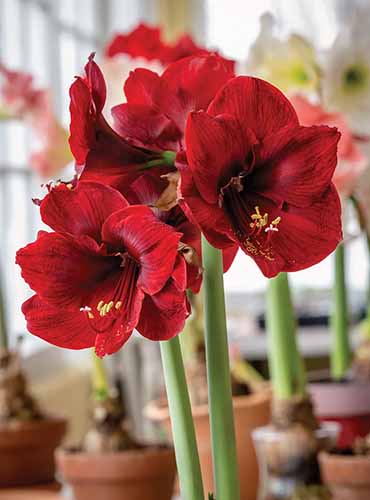
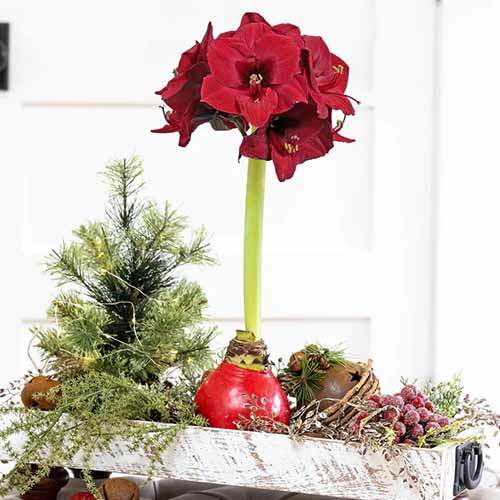
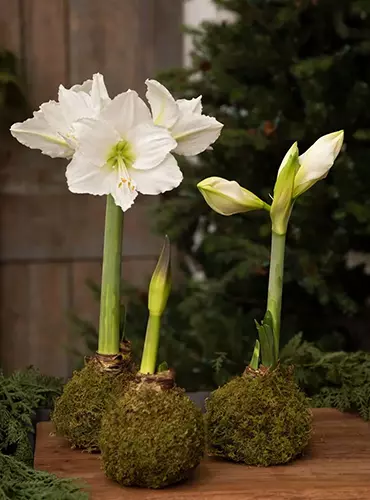

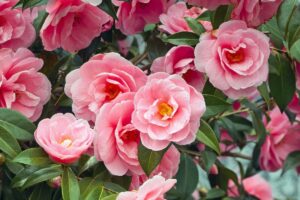

Amaryllis 2021
Hi Marie –
Your amaryllis plants are gorgeous! Thank you for sharing these lovely photos. Enjoy!
ok my name is Melody Hi Hello Everyone my thing is im the one person on earth that DOES NOT HAVE A GREEN THUMB not at all. NOW EVERYONE out there don’t you dare laugh but I ALL MY LIFE HAVE ALWAYS BELIEVED THAT JUST LOOKING OR WALKING CLOSE TO ANYWHERE THAT GROWS FROM THE GROUND UP WILL 99.9% DIE WITHOUT A DOUBT. NOW for some reason a family member gave me a WAXED AMARYLLIS and as expected I think that it’s dead, I killed it. so WHAT the hell am I to do with it BECAUSE it don’t look… Read more »
Hi Melody – Your family has faith in you, and so do we. Amaryllis bulbs do look dead when you first get them, because they’re dormant. Bulbs in pots of soil get watered, however, those encased in wax require no water. If you accidentally watered your bulb, it may have rotted inside the wax enclosure. In that case, it would seem to be mushy, and maybe have an odor. Provided it is firm and dry, some warmth may do the trick. Find the sunniest, warmest place in your home and put it there. Hopefully it will sprout soon. Remember, none… Read more »
Here are pictures of my amaryllis . Just need to know how to store the bulbs after they stop blooming.
Hi Pat – You can store the bulbs in their pots. Allow them to dry out, and let the foliage wither. Don’t cut it, as it feeds next year’s flowers. Keep the pots in a cool, dry location with a temperature of 45-50°F. You can also remove the bulbs from their pots, wash and dry them, and store them in a cardboard box. Do not water them during dormancy. To break dormancy and encourage another bloom, return the bulbs to a 75-80°F location where they can sprout. Use sterile potting medium to pot up bulbs that were stored in a… Read more »
This is my double flowering Aphrodite Amaryllis. I bought it at my garden center unposted. The bulb was large. It is truly majestic. Double scapes.
Hi Mary –
What an outstanding example of the range of amaryllis cultivars!! Thank you for sharing.
Want to learn to grow amaryllis indoors
Hello Rajesh –
We are happy you have come to Gardener’s Path to learn to grow amaryllis indoors.
First time ever grown indoors, brightened our lockdown.
Hello Jaffer –
Thank you for sharing your beautiful photos! Flowers definitely lift the spirit during trying times.
Hi I’m asking about an amaryllis that bc I planted for a client. I followed potting instructions with the bulb & soaked the soil block & planted the bulb with the top half out of the soil. I have watered it weekly and have 5 14″ leaves sprouted yet no flower yet. I’m currently suspending water as maybe I should not have watered before any bloom. Yet instructions say bloom in 4-8 weeks and next week is 8 weeks. Any advice? Please respond we are looking forward to flowering blooms! Thank you!
Hello Sheila – It’s possible that your bulb is overwatered. To grow an amaryllis indoors, thoroughly moisten the soil around the bulb. Keep it moist, but never soggy, until green sprouts appear. Then, moisten the soil only when the top two inches feel dry to the touch, and always before the pot completely dries out. If the leaves are shading toward yellow, they are definitely oversaturated. Another likely cause is inadequate light. And finally, it may be that the problem lies with the potting medium itself. If it is too rich, especially with nitrogen, it can promote too many leaves… Read more »
please may I join
Welcome Dorothy –
We’re glad you’ve found us on Gardener’s Path, and happy to hear you like amaryllis.
Hi may I join. I received a amaryllis as a present it has stopped blooming and now all we see is the stalk and what I believe to be seed pods, what do I do now.?
Hi Lynda –
Welcome! If you’d like to try growing amaryllis from seed, you can leave the flower stalk intact and collect the seeds when they are dry.
Otherwise, you can cut the flower stalk off about a quarter of an inch above its base, to avoid nicking the surrounding foliage. Let the leaves remain as they are. They are feeding the bulb so it blooms next year.
This is my 2021 fabulous flower
I bought an Amaryllis in December 2020, at a hardware store. Never expected to find such a wonderful gift as my amaryllis plant, in December in a hardware store, but it’s been a huge treat as it has bloomed 4 times since I bought it, with huge red flowers, and that was during the time it was in water. Now it’s planted in a good soil & has 5 leaves that are each over 12 inches tall!! Can’t wait for it to bloom again. And I’m growing it indoors, at a sunny window that gets sun from the south!! I… Read more »
Hi Marti –
We’re so happy you’ve had such a wonderful experience with amaryllis. It is fun to have beauty and life indoors in the winter.
In 2019 I won an Amaryllis in a Christmas raffle. I’d seen them before and groaned a bit as I am plantsman. Anyway rather than waste it I planted it and sure enough in no time two lovely scarlet blooms appeared. It then sat on the kitchen windowsill all year, producing a couple of long leaves that I cut down when they eventually collapsed. Move to the end of March 2021 and it looked dead as it had done for months. I was close to ditching it. Then one day I noticed the skin has split and a green shot… Read more »
Hi Chris –
Thanks for sharing! So glad you stuck with it and were rewarded with a second fabulous bloom!